Mickey Mouse, Donald Duck, and an army of their kindred cartoons join the war effort at home and overseas.
By David Lesjak
In this illustration for the September 1942 issue of Coronet magazine, characters from Disney’s menagerie take part in home front and front line activities. Donald Duck, as a marine, symbolizes that the pen is now equal to the sword, while other characters represent a variety of wartime roles: Thrifty Pig symbolizes the might of industry, Minnie Mouse is a Red Cross volunteer, Dopey the dwarf purchases war bonds, Flower the skunk is a member of the chemical warfare service, and Thumper the rabbit is in the army signal corps. The insignia characters for the Flying Tigers and the PT boat Mosquito Squadron in the sky represent two of more than 1,200 designs created at the Disney studio.
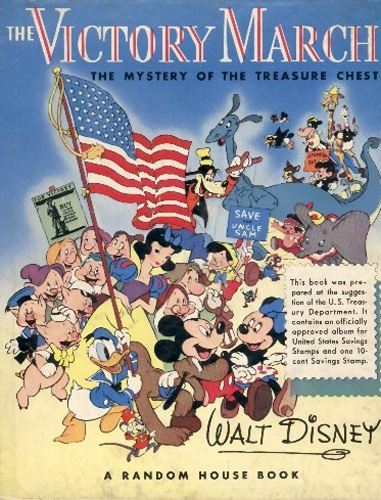
Disney’s biggest home front endorsement was for the Treasury Department. The studio produced two income tax films and a multitude of bond- and savings-related advertising, making the department one of the studio’s largest wartime customers. The Victory March interactive mechanical book was published in 1942 to be given away as to youngsters to encourage them to purchase savings stamps. It depicts the Big Bad Wolf and two little wolves as German, Japanese, and Italian fascists. The wolves steal Donald Duck’s treasure chest, which contained a savings stamp. Disney characters chase the wolves around various Washington, DC, monuments. Written on behalf of Treasury, the book originally included a savings booklet and one free war savings stamp.
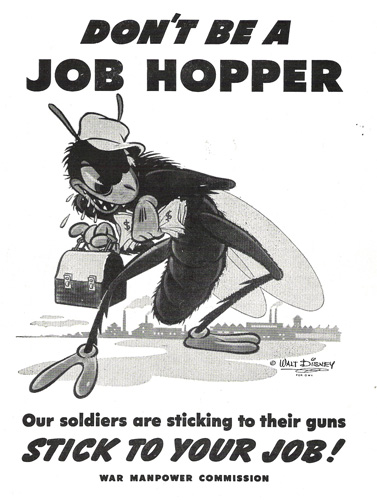
Disney artists created a wealth of war-related material for many other federal, state, and local government departments and agencies besides Treasury. This illustration was designed for the War Manpower Commission in 1943, to try and convince employees to stay at the jobs they were trained to do and help ease the critical manpower shortage caused by men being drafted into the military. It appeared in several magazines and was issued as a poster.

Disney supplied art to dozens of organizations promoting various home front activities, from salvage and scrap campaigns to blood donor drives. This promotional booklet, published for the Los Angeles War Chest in 1943 and distributed to school children, tells the story of Chesty, his two helpers Polly and Paul, and their helicopter friend Coptie. The comic-strip-style story chronicles the group’s travels–dropping supplies gathered by the war chest to children and guerrilla fighters around the world, and delivering money to a boy’s home and a hospital. The story concludes with Polly and Paul returning to school, where they encourage other children to help the war chest with their charitable work.
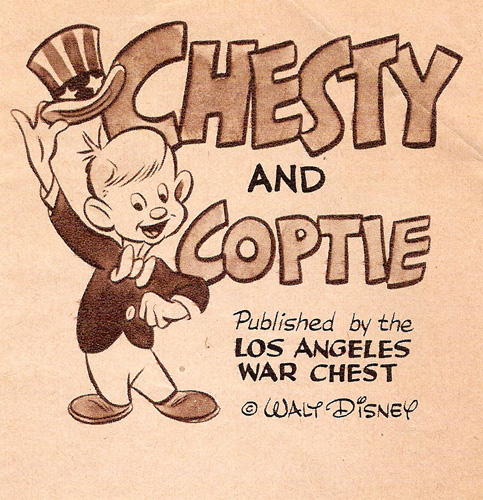
This second Los Angeles War Chest booklet, published in 1944, features the same lead characters as the first. In this edition, the booklet’s message has been updated to include current events: the German buzz-bomb attacks on England; the second front in Europe, created by the D-Day landings in Normandy; and B-29 bomber bases being built in China.
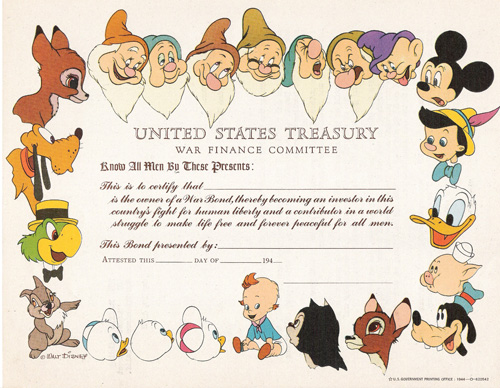
The Fifth War Loan Drive in 1944 included the Series E small denomination bond. Disney allowed certificates to be printed using the images of its most popular characters to promote the Bonds for Babies campaign. One certificate was given to everyone who purchased a bond in the name of a baby or young child.

During the war Americans had to deal the inconvenience of food rationing. Sugar and coffee were the first items to be rationed, followed by processed foods and meat and dairy products. This circa 1943 booklet was held ration coupons. Mickey, Minnie, Donald, and Pluto are pictured on the cover, with seemingly satisfied expressions, after leaving the Super Duper Market with their purchases.
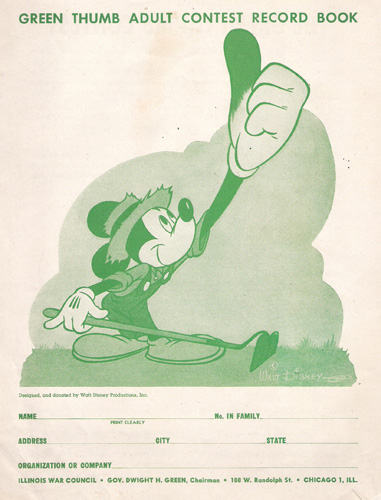
Among the most successful civilian participation campaigns was the one for Victory Gardens, which encouraged Americans to grow and preserve their own fruits and vegetables. This softcover Green Thumb Contest Record Book was used for recording the types of crops grown and their quantity and weight. Contests were held at the local, state, and national levels, with the national winner taking home a $1,000 war bond. Three variations of this book exist. All were created for the Illinois War Council.
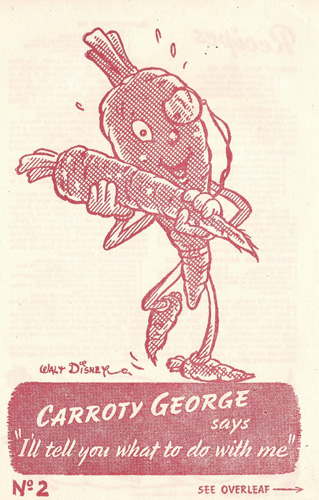
While Americans struggled to cope with food shortages and rationing, the citizens of the isolated island nation of Britain suffered even more. In late 1941, Walt Disney had artist Hank Porter design a family of carrots for England’s food minister. The January 11, 1942, New York Times Magazine announced, “England has a goodly store of carrots. But carrots are not the staple items of the average English diet. The problem…is to sell carrots to (the) country.” The front of this flyer features an illustration of Carroty George, and the reverse, six different carrot recipes. The entire family of Disney-designed carrots included Dr. Carrot, Pop Carrot, and Clara Carrot. They were reproduced on a poster, in a recipe booklet, and in an extensive newspaper ad campaign.
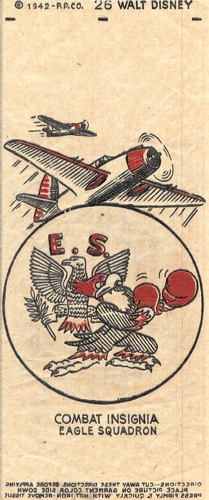
Over the course of the war, Disney artists designed more than 1,200 combat insignia for all branches of the US military and for its allies. Besides the famed Flying Tigers insignia, one of the most celebrated designs was made for England’s Royal Air Force. Prior to Pearl Harbor, many American pilots joined England’s Royal Air Force as members of Eagle Squadrons 71, 121, and 133. An entry in a Hearst newspaper insignia stamp album stated, "Walt Disney artists were quick to chronicle the significance of this combat union with an American Eagle ‘on guard.’ Fiercely he advances to contest the fouling tactics of a barbarous and un-sportsmanlike adversary, as he moves in to the attack with his English ‘comrade-at-arms.’”
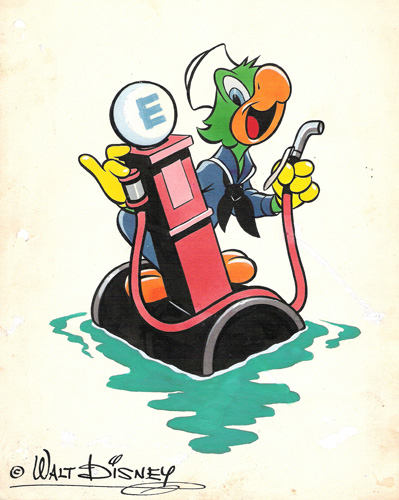
The insignia for the USS Escambia (AO-80) fleet refueler was created by famed Disney artist Hank Porter, the man responsible for creating the lion’s share of combat designs at the studio during the war. Escambia, named after a river that flows through Georgia and Florida, fueled ships during the invasion of the Marshall Islands, aircraft carriers as they launched strikes against the Philippines, task forces vessels supporting the invasion of Okinawa, and aircraft flying raids against Japan. This mobile naval gas station was represented by a 50-gallon drum and Jose Carioca, a character made famous in Disney’s two South American films, Saludos Amigos and The Three Caballeros. Virgil Grier, who served aboard the Escambia said, “Ken Hackett reproduced the insignia on each side of the bridge, where it drew admiring chuckles from the crews of the ships we refueled.”
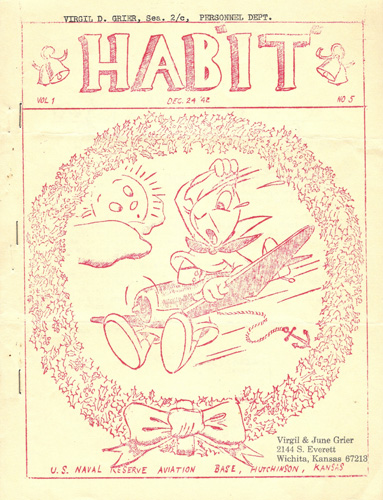
The newletter for the US Navy Reserve Aviation Base in Hutchinson, Kansas, was called the "Hab”it’"–"Hab" for Hutchinson aviation base, plus "it"–and was published biweekly. Volume one, number five, a 20-page edition published in December 1942, featured the base insignia on its front cover: Jiminy Cricket in an airplane with a trailing anchor, which signified that Hutchinson was a navy base. The design was created in October, but made its first public appearance here.

Christmas was often a depressing time of the year for men serving overseas. To help raise morale, many units created their own custom holiday greeting cards. Units with Disney-designed insignia often incorporated their insignia into the design of their cards. This particular postcard was sent out by men serving aboard the navy fleet oiler USS Housatanic (AO-35). This tanker saw action in both the Atlantic and South Pacific, where she delivered fuel oil for warships and high-octane gasoline for aircraft.

The cover of the 13th Armored Division’s greeting card featured the unit’s Disney-designed insignia, a collection of bad luck symbols. Men in this unit paid no attention to the superstitious overtones of their unit number. They felt it was the enemy who would suffer misfortune when encountering them.
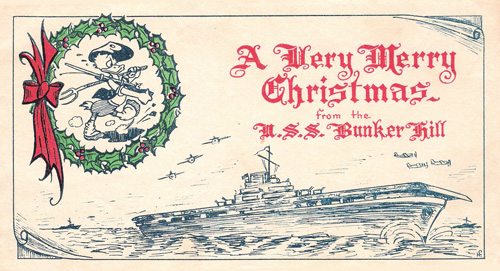
The USS Bunker Hill (CV-17) was an Essex-class aircraft carrier that saw extensive action in the South Pacific. Supporting the invasion of Okinawa, Bunker Hill was severely damaged when two Japanese kamikaze pilots successfully crashed into her. The resulting explosions killed more than 340 crewmen.

While many units produced matchbooks imprinted with their insignia, this 1942 box of 12 Maryland Match Company insignia matchbooks was sold at corner grocery stores and five and dime shops across America. There were a total of 20 different matchbooks in the series. Each pictured a Disney insignia on the front side and the name of the unit on the reverse.

Besides creating combat insignia, Disney artists designed corporate logos for several military contractors. This colourful certificate features the Beech Aircraft Company’s Disney-designed insignia. The Beechcraft Busy Bee Honorary Award of Merit was given employees and subcontractors who met or exceeded productivity levels and who contributed ideas to help the company operate more efficiently. A cloisonné pin in the shape of the insignia design was also distributed to employees.
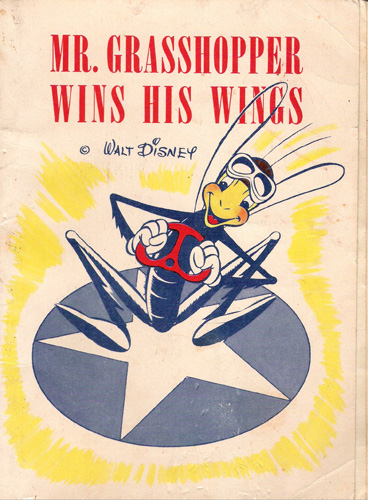
This 26-page booklet was published by the Aeronca Aircraft Corporation in 1943. The booklet told the story of the Aeronca Grasshopper, a multi-purpose airplane. The Grasshopper was used for artillery spotting, scouting, and air ambulance duties. Disney artists drew all of the illustrations in the booklet, as well as the corporate logo on the front cover. The general public could receive a copy of the booklet by sending 10 cents in stamps to Aeronca’s publicity department.

This whimsical training booklet was created for the US Army Air Force, Safety Education Division, Flight Control Command. The concept simple: make a manual that would hold the attention of an airman while teaching him the basic principles of cold weather flying in a fun manner. Through humorous sketches, the booklet details the perils Allied airmen could face while flying at high altitudes and in the very cold. The featured characters are spandules, the winter cousins of author Roald Dahl’s mythical gremlins, which wreaked havoc on aircraft.
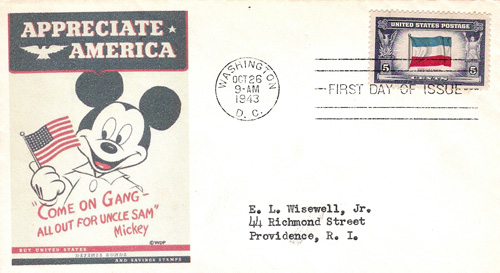
The Appreciate America illustration on this cachet was originally designed by Disney for the US Department of Education in the fall of 1941. The department had a series of eight patriotic posters created that featured different cartoon strip characters, including Donald Duck, the Gumps, Orphan Annie, Joe Palooka, and Harold Teen.

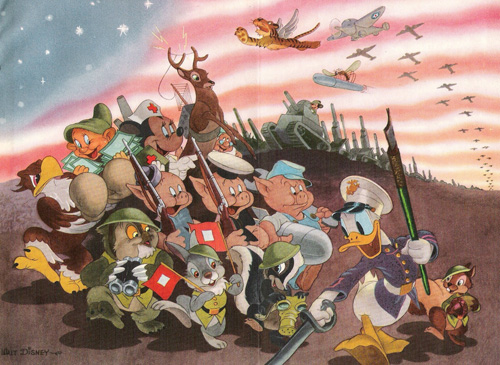

FOLLOW US »
